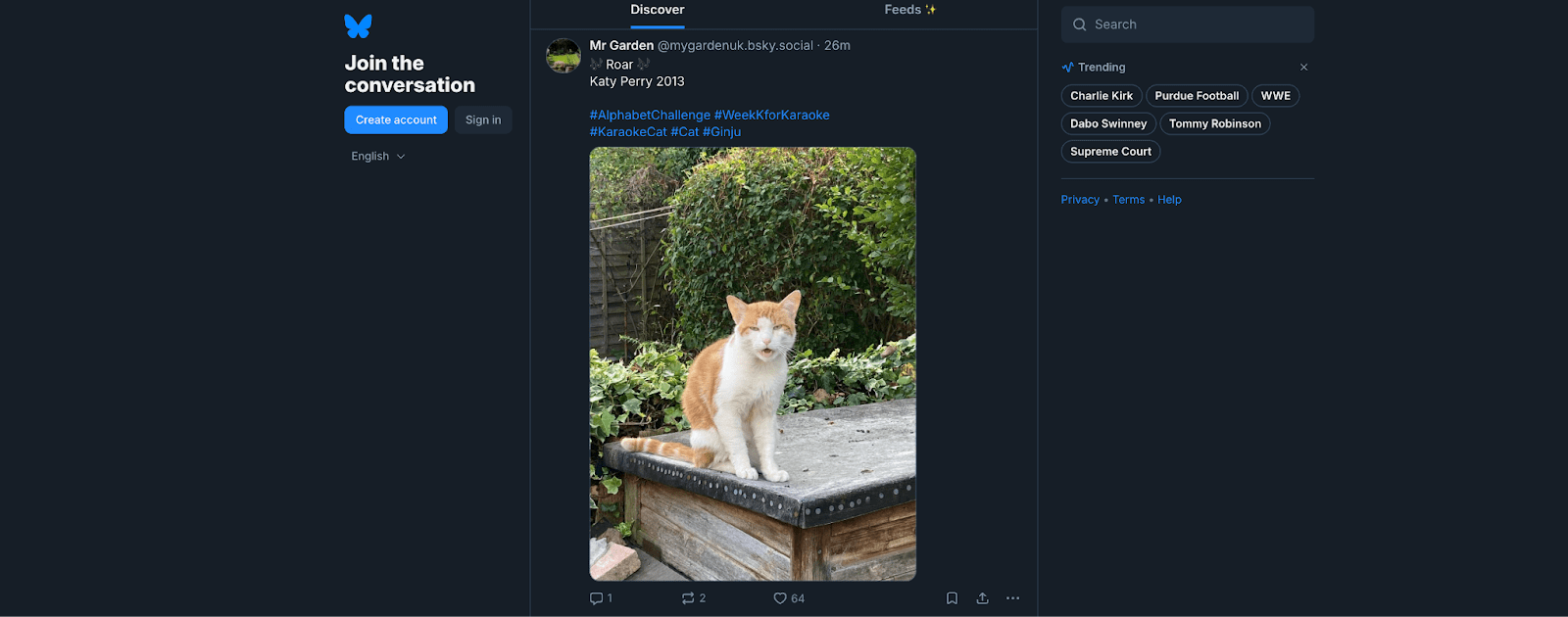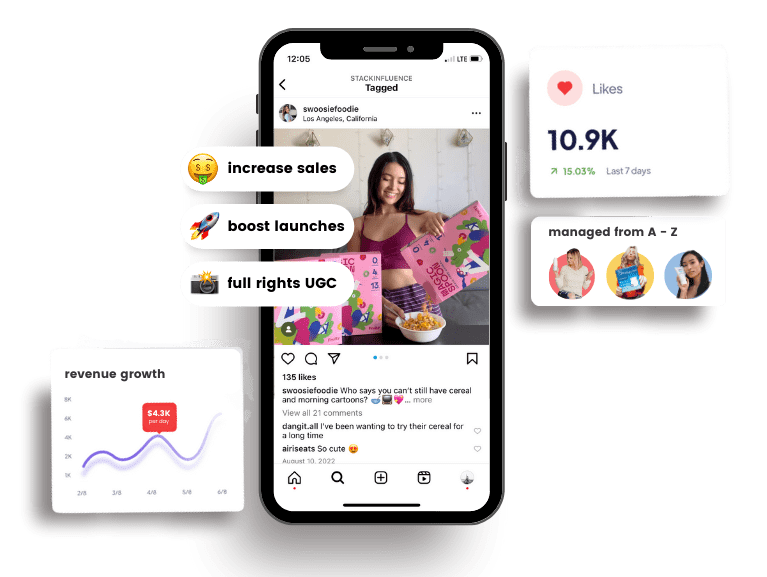How Does BlueSky Work?
8th
October, 2025
Influencer Marketing
Amazon Marketplace
Artificial Intelligence
TikTok Tips
Bluesky has been making headlines as the hottest new social media app, often touted as the next big Twitter alternative. This decentralized platform, backed by Twitter’s co-founder Jack Dorsey, promises a more user-centric experience—one that’s attracting micro influencers, content creators, and curious users alike. But what exactly is Bluesky, how does it work, and why are people flocking to it? Let’s break it down in a casual, informative way so e-commerce brands, Amazon sellers, and creators can understand its potential.
Bluesky’s user base has grown explosively since its public launch, reflecting surging interest in this new social network. In late 2024, the platform surpassed 20 million users amid waves of people departing Elon Musk’s X (formerly Twitter). By early 2025, Bluesky crossed the 30 million user milestone and continued climbing to over 38 million registered users as of mid-2025.
What is Bluesky?

Bluesky is a decentralized, text-centric social media platform built on an open-source framework called the AT Protocol. In plain English, this means Bluesky isn’t owned and operated by a single company like traditional social networks. Instead, its underlying protocol is open for developers and communities to contribute to or even create their own interconnected social apps. Bluesky was originally conceived in 2019 as a project within Twitter, but it evolved into an independent entity (led by CEO Jay Graber) that launched publicly in early 2024. It’s widely seen as a fresh start for social networking, especially for those disillusioned with the direction of Twitter under Musk’s leadership.
At its core, Bluesky functions a lot like Twitter (now X) or Instagram Threads in terms of user experience. It’s a microblogging service where users share short posts, follow each other, and engage in conversations. However, what makes Bluesky stand out is its emphasis on decentralization and user control. Because it operates via the AT Protocol, anyone can run a Bluesky server or build compatible apps, giving users the potential to port their data and identity across different platforms that speak the same language. In other words, you’re not locked into one corporation’s ecosystem—a big deal for creators who worry about losing followers or content if a platform goes sour.

Unlock the Power of Micro Influencers and Elevate your Brand Today!

How Does Bluesky Work? (Features & User Experience)
Bluesky’s interface and features will feel familiar to anyone who’s used Twitter, making it easy for newcomers to get started. Here’s a quick rundown of how it works and what you can do on Bluesky:
-
-
- Signup and Handle: To join Bluesky, you simply sign up via the mobile app or website (it exited its invite-only beta in February 2024, so anyone can join now). Upon joining, you create a unique handle in the format @username.bsky.social. This handle works much like a Twitter handle, and you can even use your own custom domain as a handle if you want to verify your identity (for example, @yourname.com) – a nifty feature for brands and creators who want authenticity.
- Posts (Skeets): On Bluesky you share short text posts (unofficially nicknamed “skeets” by the community – a playful mix of “sky” and “tweet”). Posts can be up to 256 characters long, and you can attach photos or even short videos now that the app has added multimedia support. Just like other platforms, you can reply to posts, like them, or repost (re-share) someone else’s post to your own followers. There are no super flashy content formats (no Stories or Reels equivalent yet) – it’s a back-to-basics focus on concise updates and conversations, which many content creators actually find refreshing.
- Two Main Feeds: Bluesky offers two primary timelines for browsing content. The Home feed shows posts from people you follow, giving you a personalized stream much like Twitter’s following timeline. Then there’s the Discover feed, which highlights trending posts and new content from across the network. Discover is great for finding interesting conversations and creators beyond your own following list. For a micro influencer looking to expand their audience, appearing on Discover (via an engaging post) can attract new followers.
- Custom Feeds (Algorithmic Choice): Here’s where Bluesky starts to differentiate itself. The platform is built with a “marketplace of algorithms” concept, meaning users can subscribe to custom feeds curated by the community. Beyond the default Home and Discover feeds, you might find or create niche timelines – for example, a feed just for Amazon sellers sharing e-commerce tips, or a feed of posts about photography. Bluesky’s app lets you toggle between these feeds easily. This feature gives content creators and users more control over what content they see, rather than being stuck with one algorithm. In Bluesky’s decentralized spirit, if you don’t like how the main algorithm ranks posts, you could switch to another feed or even build your own!
- “Starter Pack” for New Users: To help people get started, Bluesky provides an optional Starter Packs feature. These are essentially pre-curated lists of popular accounts and topics that you can follow with one click. For example, there might be a starter pack for tech enthusiasts, one for fashion & beauty creators, another for comedy, etc. This is helpful for new users (including aspiring micro influencers) to quickly plug into relevant communities without having to find everyone from scratch.
- Decentralized Account & Data: Because Bluesky is built on the AT Protocol, your account isn’t tied to a single corporate database. In practical terms, this means down the line you might be able to move your account (and followers) to a different server or app that uses AT Protocol without losing your social graph. While today most people simply use the official Bluesky app and default server, the project’s long-term vision is to enable a federation of servers (much like email or Mastodon) all speaking to each other. For everyday users and creators, this promises more ownership of your online identity – you won’t be at the mercy of one company’s whims. Imagine being able to take all your followers from one app to another if you wanted! That’s the kind of user empowerment Bluesky is going for.
- User Control & Moderation: Bluesky has leaned into community moderation tools to keep the platform healthy. After some early growing pains, the developers implemented robust blocking and muting features (yes, the classic block is alive and well, unlike the controversial block removal Musk floated on X) and even user-managed content labeling for filtering out unwanted material. The app also allows third-party moderation services, meaning communities could collectively decide on their own moderation rules if they host their own servers. For creators, this environment can feel safer and more transparent. Bluesky’s team has also been clear about privacy – notably committing not to use user-generated content for AI training purposes, a stark contrast to some other platforms. So you won’t have to worry that your witty post will secretly train a chatbot without your consent.
- No Ads or Algorithms Pushing Content: Currently, Bluesky does not have ads cluttering the feed, and while it uses an algorithm for Discover, it isn’t aggressively curating your Home feed beyond chronological posts from those you follow. This puts more power in the hands of users and content creators. It also means growth on Bluesky is a bit more organic – you don’t have an algorithm randomly making you go viral; it’s more about real human-to-human interaction. For brands and e-commerce sellers, this lack of ads means if you participate, you have to do so as a regular user, not an advertiser, which can actually lead to more authentic engagement if done right.
- Signup and Handle: To join Bluesky, you simply sign up via the mobile app or website (it exited its invite-only beta in February 2024, so anyone can join now). Upon joining, you create a unique handle in the format @username.bsky.social. This handle works much like a Twitter handle, and you can even use your own custom domain as a handle if you want to verify your identity (for example, @yourname.com) – a nifty feature for brands and creators who want authenticity.
-
Why Is Bluesky Gaining Popularity?
It seems like everyone from tech enthusiasts to influencers is suddenly talking about Bluesky. The platform’s rapid growth (at one point Bluesky was reportedly adding over 6 new users per second during its surge) didn’t happen by accident. Several factors have been driving its popularity:
1. Transparency and User Control: Many users were drawn to Bluesky for its open-source, decentralized ethos. After years of opaque algorithms and policy flip-flops on mainstream networks, people crave a platform where they have more control. Bluesky’s commitment to transparency—by open-sourcing its code and letting the public see how it’s built—instills trust. Notably, when Elon Musk announced changes like weakening Twitter’s block feature, users started seeking a safer, more transparent alternative. Bluesky’s philosophy of letting users shape their experience (through custom feeds and community input) has been a breath of fresh air.
2. Backlash to Twitter (X) Policies: The turmoil at Twitter (now X) under Elon Musk has indirectly fueled Bluesky’s rise. In late 2023 and 2024, Twitter introduced a string of controversial policy changes and faced public scandals – from sudden paywalling of APIs to Musk’s political endorsements. In the wake of the heated 2024 U.S. election season, a significant number of users grew dissatisfied with X’s direction. Some high-profile figures and communities left or reduced their Twitter usage. Bluesky, with its similar feel but promise of a cleaner slate, became the new home for many of these disillusioned users. Essentially, Twitter’s loss became Bluesky’s gain.
3. Global Events Driving Adoption: Bluesky’s growth got an extra boost from some external events. For instance, when Twitter was temporarily banned in Brazil, a huge wave of Brazilian users flocked to Bluesky as an alternative. (Brazil now accounts for one of the largest chunks of Bluesky traffic by country – proof that people will quickly jump ship when their favorite platform falters.) Similarly, other communities around the world have used Bluesky as a refuge when Twitter faced outages or unpopular changes. These spikes in sign-ups created network effects, where each new influx of users made Bluesky more lively and attractive for the next.
4. Early Hype and Exclusivity: Let’s not underestimate the power of FOMO. Bluesky launched as an invite-only app in mid-2023, which immediately gave it an aura of exclusivity. Getting a Bluesky invite code became a hot ticket for a while. Early adopters (including many content creators and tech influencers) were eager to snag their username and explore the new space. This buzz created a virtuous cycle — the more people talked about “hey, who has a Bluesky invite?” on other socials, the more others wanted in. By the time Bluesky opened to the public in February 2024, it already had a waiting list of enthusiastic users and a certain cachet as the new place to be. Riding on that momentum, Bluesky quickly climbed app store charts (even hitting the #1 social app spot on iOS during its surge), which in turn attracted yet more users. In short, being new (and a bit hard to get into at first) was a marketing win for Bluesky.
Despite all this growth, let’s keep perspective: Bluesky is still smaller than the giants. It has tens of millions of users, whereas Meta’s Threads amassed around 100+ million at launch and Twitter/X claims hundreds of millions. But Bluesky’s rapid trajectory and passionate community suggest it’s carving out a meaningful niche. Its appeal lies in being the cool new hangout that isn’t flooded with ads or dictated by a big corporate algorithm – a place where user-generated content feels genuinely user-generated, not strategically amplified. For micro influencers and creators, that environment is attractive because you’re engaging with an audience that’s truly listening, not just doom-scrolling through noise.
Should Influencers, Brands, and Creators Join Bluesky?

If you’re a micro-influencer, content creator, or a brand (like an e-commerce or Amazon seller), you might be wondering: “Is Bluesky worth my time?” The honest answer: It depends on your goals, but it’s definitely worth grabbing your spot and keeping an eye on. Here are a few considerations:
-
-
- Early Adoption vs. Audience Size: Bluesky’s user base, while growing fast, is still relatively small compared to Instagram, TikTok, or even Twitter. If you’re an influencer whose strategy relies on sheer reach and big numbers, Bluesky won’t deliver that scale yet. However, what it lacks in size it makes up for in engagement quality. The community is very enthusiastic and discussions can be more meaningful. Being an early adopter could pay off later – you can establish yourself as a leading voice in your niche on Bluesky before it potentially blows up. (Some creators who were early on TikTok or Instagram reaped huge benefits; the same could happen on Bluesky if its growth continues.)
- Authentic Engagement is Key: Currently, Bluesky is a no-frills, community-driven platform. Users are there for genuine conversations, not to be marketed at. Traditional influencer marketing content, like overt #ad or #sponsored posts, can feel out of place in the Bluesky feed right now. In fact, coming on too strong with promotions might earn backlash from this authenticity-valuing community. So, if you’re a brand or influencer, the approach should be subtle and value-driven. Share useful insights, engage in conversations, post relatable content – basically, be human. For example, an Amazon seller could share behind-the-scenes stories of product creation or invite feedback, rather than just posting “Buy my product!” ads. A beauty micro-influencer might post candid reviews or tips without the hard sell. By focusing on UGC-style content (user-generated content that feels organic and not like an ad), you’ll integrate much more smoothly into the Bluesky ecosystem.
- No Ads, No Official Pages (Yet): Bluesky currently doesn’t offer advertising options or special business profiles. Every account is a regular user account. This levels the playing field – Stack Influence and other marketing platforms can’t run programmatic ad campaigns on Bluesky at this time, and brands can’t push sponsored posts through an ad manager. Instead, growth comes from community interaction. For marketers, this is both a challenge and an opportunity. The challenge is you can’t rely on paid reach; the opportunity is that any traction you get is real. If someone reposts your content or follows you, it’s because they truly liked it, not because an algorithm forced it onto their screen. Some forward-thinking brands are using Bluesky to listen and converse rather than sell – for instance, joining threads related to their industry, answering questions, and showing personality. This kind of community building can foster loyal fans in the long run.
- Influencer Campaigns – Caution for Now: Given the above, running a full-fledged influencer marketing campaign on Bluesky is premature. You won’t find the campaign management tools you have on established platforms, and regular users might be skeptical of overt promotions. In fact, the team at Bluesky and many users seem protective of the platform’s vibe. A blatant sponsored post or a flood of brand hashtags could come across as spammy. The current advice (which we echo) is to hold off on heavy promotional campaigns on Bluesky in these early days. Instead, use the time to experiment and learn. Engage with your micro community there: What topics get them excited? What kind of content do they repost or discuss? By the time Bluesky matures and possibly introduces more creator tools (they’ve been rolling out features like DMs and video uploads recently, with more likely on the way), you’ll be ready to leverage them in an authentic manner.
- Secure Your Handle: One simple thing every creator or brand should do is sign up and secure your handle on Bluesky. Even if you’re not active there yet, grab your brand name or personal name. This ensures two things: (1) someone else doesn’t impersonate or squat on your name, and (2) you have the option to build your presence later. It’s like claiming your domain name early. Plus, you might find value in lurking and observing for a while – see what your audience (maybe your customers as influencers in their own right) are talking about on Bluesky. Some companies have done this and found it provides unfiltered insight into customer sentiment, which is marketing gold.
- Early Adoption vs. Audience Size: Bluesky’s user base, while growing fast, is still relatively small compared to Instagram, TikTok, or even Twitter. If you’re an influencer whose strategy relies on sheer reach and big numbers, Bluesky won’t deliver that scale yet. However, what it lacks in size it makes up for in engagement quality. The community is very enthusiastic and discussions can be more meaningful. Being an early adopter could pay off later – you can establish yourself as a leading voice in your niche on Bluesky before it potentially blows up. (Some creators who were early on TikTok or Instagram reaped huge benefits; the same could happen on Bluesky if its growth continues.)
-

Unlock the Power of Micro Influencers and Elevate your Brand Today!

Conclusion to How Does BlueSky Work?
Bluesky is definitely a platform to watch. It’s not the place for hard selling or polished ad campaigns today – and that’s okay. Its strength lies in community and conversation, aligning perfectly with the direction of modern micro-influencer marketing (which prizes authenticity over mass advertising). At Stack Influence, we’ve seen that authentic engagement often trumps flashy promotion, and Bluesky is an emerging testament to that trend. Whether you’re a curious content creator or an e-commerce entrepreneur, it’s worth exploring Bluesky, if only to stay ahead of the curve. Secure your spot, join the conversation, and who knows – you might just find a refreshing new outlet for your creativity.

By William Gasner
CMO at Stack Influence
William Gasner is the CMO of Stack Influence, he's a 6X founder, a 7-Figure eCommerce seller, and has been featured in leading publications like Forbes, Business Insider, and Wired for his thoughts on the influencer marketing and eCommerce industries.
Want new articles before they get published? Subscribe to our Awesome Newsletter.
stack up your influence
turning creativity into currency
our headquarters
111 NE 1st St, Miami, FL 33132
our contact info
[email protected]
stack up your influence
turning creativity into currency
our headquarters
111 NE 1st St, 8th Floor
Miami, FL 33132


